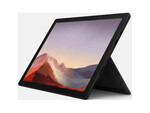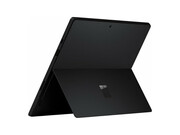Microsoft Surface Pro 7, i5-1035G4
Specifications

Secondary Camera: 5 MPix
Price comparison
Average of 3 scores (from 5 reviews)
Reviews for the Microsoft Surface Pro 7, i5-1035G4
Source: Techradar
 Archive.org version
Archive.org versionWe expected a bit more in advancements from the seventh Surface Pro tablet. USB-C is nice, but for a device at this price, its should be Thunderbolt 3. Plus, the display bezels are awfully thick for a tablet in 2019. The Surface Pro 7 isn’t big enough of a leap over the Pro 6 for us to recommend it to either upgraders or folks just getting into Microsoft’s tablet.
Single Review, online available, Very Long, Date: 10/21/2019
Rating: Total score: 70%
Source: Engadget
 Archive.org version
Archive.org versionThe Surface Pro 7 is pretty much the same as the Surface Pro 6, with one important difference: USB-C. You’ll also get improved performance and microphones, but at the expense of battery life. The Pro 7 is a good hybrid PC, especially for those who’ve been waiting for the new port, but it’s otherwise not worth spending $750 to upgrade.
Single Review, online available, Long, Date: 10/21/2019
Rating: Total score: 82%
Source: The Verge
 Archive.org version
Archive.org versionThe Surface Pro X looks like it’s now attempting to set the stage in terms of raw hardware for competitors to catch up to, and we’ll now need to see if the Pro X can even come close to matching the performance of the Surface Pro 7. That’s highly unlikely, which will leave the Surface Pro 7 needing to catch up to the design of the Surface Pro X next year.
Single Review, online available, Long, Date: 10/21/2019
Rating: Total score: 80%
Source: Techradar
 Archive.org version
Archive.org versionFrankly, the new Surface Pro 7 has us scratching our heads. For all intents and purposes, this is a spec update to the preceding Surface Pro 6. We will definitely see a sizeable boost in performance but battery life seems to take a massive hit as well, with little to no explanation. It charges much faster, but how much good is that when the device’s lasting power has dropped 30%? The Surface Pro 7 is a baffling upgrade to the existing model. It has virtually zero tangible design changes short of a new port, while performance takes a weird turn that's arguably for the worst. We'll save our full judgments for a full review, of course. Still, consider us apprehensive.
Single Review, online available, Long, Date: 10/12/2019
Foreign Reviews
Source: Ofertaman
 ES→EN Archive.org version
ES→EN Archive.org versionPositive: Good price / power ratio; stylish design; USB-C; long battery life; quick charging; silent system. Negative: No accessories; only 128GB SSD; weak connectivity; heavy.
Single Review, online available, Very Short, Date: 10/14/2020
Comment
Series:
Microsoft Surface Pro (2017) is the fifth generation in the Surface Pro family. The Surface Pro is solid as a rock and exudes a sense of futuristic quality. It’s also well-designed, with a look and feels that, while minimally changed from the Surface Pro 4, is still an improvement. The corners are more rounded, and the exhaust vents along the edges are less pronounced. There aren’t many moving parts in the Surface Pro itself. The power and volume buttons along the top are easy to find by feel, and have a crisp action, while the kickstand is smooth and reliably holds the tablet at chosen angle. It now opens up to 165 degrees, an increase from the Surface Pro 4, which opened 150 degrees. Fully flexed, the kickstand can turn Surface Pro into a nearly-flat slate. If a user decides to flip into tablet mode for a moment and fold back the Type Cover, the keyboard will turn off when the cover is tucked back. It can even switch Windows 10 into tablet mode if desired. It attaches to the tablet with strong magnets and connects via a physical port, meaning there’s zero lag when typing. The Surface Pro sports two front-firing speakers on each side of the display. There are small cutouts in the glass to let the sound through, and the design provides impressive sound for a tablet. Music is great, with surprising range, and there’s even a hint of bass. The speakers also get surprisingly loud and can fill a decent sized room without distorting.
The Surface Pro features up to a seventh-generation Intel Core i7, 16GB of RAM, and a 1TB SSD. It is seen that the Surface Pro offers a cutting-edge CPU, solid RAM and SSD options, and full support for all of Microsoft’s most innovative Windows 10 technologies. All that will keep the machine relevant for years to come. The Surface Pro is refreshingly light on bloatware. While it’s stocked with the usual Microsoft Windows 10 apps and a handful of casual games, it’s otherwise unencumbered with junk software. The Surface utility is also a nice app that offers the ability to configure the Surface Pen and get some useful information about your machine. Microsoft is using a 45-watt-hour battery in the Surface Pro, which is an increase from the 38 watt-hour battery that was packed into the Surface Pro 4. The Surface Pro also uses more efficient seventh-generation Intel Core processors. Taken together, the new model offers improved battery life over its predecessor. The Surface Pro is eminently portable, at 0.33 inches thick and 1.73 pounds. Even with the Signature Type Cover attached, the machine is easy to carry around and slip into a bag. It might not be quite as thin and light as the iPad Pro, but it’s also a much more powerful machine that can run real PC applications. The Surface Pro bring a whole new meaning to the word tablet. It is a iPad like device but is actually a real computer.
Hands-on article by Jagadisa Rajarathnam
Intel Iris Plus Graphics G4 (Ice Lake 48 EU): Integrated graphics card in Intel Ice-Lake G4 SoCs based on the new Gen. 11 architecture with 48 of the 64 EUs (Execution Units / Shader Cluster). The clock rate depends on the processor model ranging from 300 MHz base to 1050 - 1100 MHz boost. The Ice-Lake chips are produced in the modern 10nm+ process at Intel produced.
Modern games should be playable with these graphics cards at low settings and resolutions. Casual gamers may be happy with these cards.
» Further information can be found in our Comparison of Mobile Graphics Cards and the corresponding Benchmark List.
i5-1035G4: A low-power, Ice Lake family processor (SoC) featuring 4 cores, 8 threads, 6 MB of L3 cache and the Iris Plus G4 (48 EUs) iGPU. This Core i5 saw the light of day in H2 2019; it is designed for use in highly portable consumer laptops. The CPU cores run at 1.1 GHz to 3.7 GHz. The Sunny Cove microarchitecture that is in use here is notable for several improvements over Skylake including support for new technologies, new instruction sets and fast LPDDR4-3733 RAM. There is no PCIe 4 support here, however.» Further information can be found in our Comparison of Mobile Processsors.




